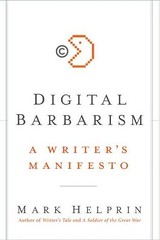As part of a revise-and-resubmit process, I’ve been spending much of my summer upgrading my draft book, Intellectual Privilege: A Libertarian View of Copyright. That effort has led me to revisit copyright’s constitutional foundations. I find them very shaky, indeed. This passage (with footnotes excerpted) explains why modern copyright law often fails “to promote the Progress of Science and the useful Arts”:
What would copyright look like if we took the Constitution at its word, requiring that copyright promote the progress of both science and the useful arts? We would then have to look askance at the current practice of affording copyright protection to such purely artistic creations as songs, plays, novels, paintings, and sculptures. Even supposing that “science” reaches broadly enough to cover all of the humane sciences—a reading that Malla Pollack documents as an original meaning of the term—copyright law today focuses far more on the expressive arts than on the “useful” ones.
Taking “Science and useful Arts” seriously would thus radically narrow the proper scope of copyright. The first Copyright Act, enacted in 1790 by some of the same people who wrote and ratified the Constitution, covered only maps, charts, and books. Permitting copyrights in first two types of works plainly promoted both science and the useful arts. Lawmakers in 1790 probably regarded books, too, primarily as tools rather than diversions. Novels had yet to rise to prominence, after all; the first American one, William Hill Brown’s THE POWER OF SYMPATHY, had appeared only the year before, and even it aimed at practical ends, promising “to Expose the fatal consequences of SEDUCTION.” Judging from the titles in libraries and on sale, fiction made up only a small portion of the books available in late eighteenth century America. The 1790 Copyright Acts moreover excluded such purely artistic expressions as songs, plays, paintings, and sculptures—even though its drafters undoubtedly knew of and appreciated those sorts of works.
It appears, then, that “[t]o promote the Progress of Science and useful Arts” originally meant that that copyrights had to serve practical ends, rather than merely expressive ones. But originalists should not alone embrace that constitutional limitation on copyright’s scope. Given that “Science” now connotes a more technical and specialized endeavor than it did in the eighteenth century, the plain, present, public meaning of the Constitution likewise counsels against extending copyright protection to purely artistic works. Whether we give the Constitution’s text its original meaning or its current one, therefore, copyright should cover little more than maps, charts, non-fiction books, illustrations, documentaries, computer programs, and architecture. Most songs, plays, fictional books, paintings, sculptures, dances, movies, and other artistic works, because they fail to promote the progress of science and the useful arts, would on that reasoning not qualify for copyright protection.
However rigorously logical, that argument against the constitutionality of almost all modern copyright law will, I grant, probably generate more grins than agreement. Courts and commentators have hitherto hardly bothered to distinguish between “Science and useful Arts”; still less have they taken those words to impose real limitations on federal power. Here as elsewhere, acquiescence to long-accepted practices has dulled us to the Constitution’s bracingly straightforward words. We should read them anew and reflect that the Founding generation did not evidently think that granting statutory privileges to such purely artistic creations as romantic operas or pretty pictures would promote the progress of both science and the useful arts. Furthermore, most citizens today would, if presented with the Constitution’s plain language rather than the convoluted arguments of professional jurisprudes, probably say the same thing about pop songs, blockbuster movies, and the like. That is certainly not to say that purely expressive works lack value. They may very well promote such important goals as beauty, truth, and simple amusement. The Constitution requires that copyright promote something else, however—”the Progress of Science and useful Arts”—and a great many works now covered by copyright cannot plausibly claim to do both.
This argument against the constitutionality of most modern copyright relies, by the way, on a prior argument about the structure of the copyright clause; to wit, that “Science and useful Arts” modifies both “authors” and “inventors.” Also, I intend to follow up the above with an analysis of how the Supreme Court in
took a view almost exactly opposite to the text-based one I’ve embraced. (I’d call that an admission, were I not proud to disagree with the Court.)

 The new episode of Surprisingly Free Conversations is up and it features Michael S. Sawyer, a fellow at the Berkeley Center for Law and Technology, discussing the impact of the DMCA on user-generated content. The discussion also turns to the principle of fair use and competing solutions for dealing with copyright infringements on user-generated content sites. You can listen to the podcast on
The new episode of Surprisingly Free Conversations is up and it features Michael S. Sawyer, a fellow at the Berkeley Center for Law and Technology, discussing the impact of the DMCA on user-generated content. The discussion also turns to the principle of fair use and competing solutions for dealing with copyright infringements on user-generated content sites. You can listen to the podcast on  In his
In his Term&MMCurve.gif )

 The Technology Liberation Front is the tech policy blog dedicated to keeping politicians' hands off the 'net and everything else related to technology.
The Technology Liberation Front is the tech policy blog dedicated to keeping politicians' hands off the 'net and everything else related to technology.